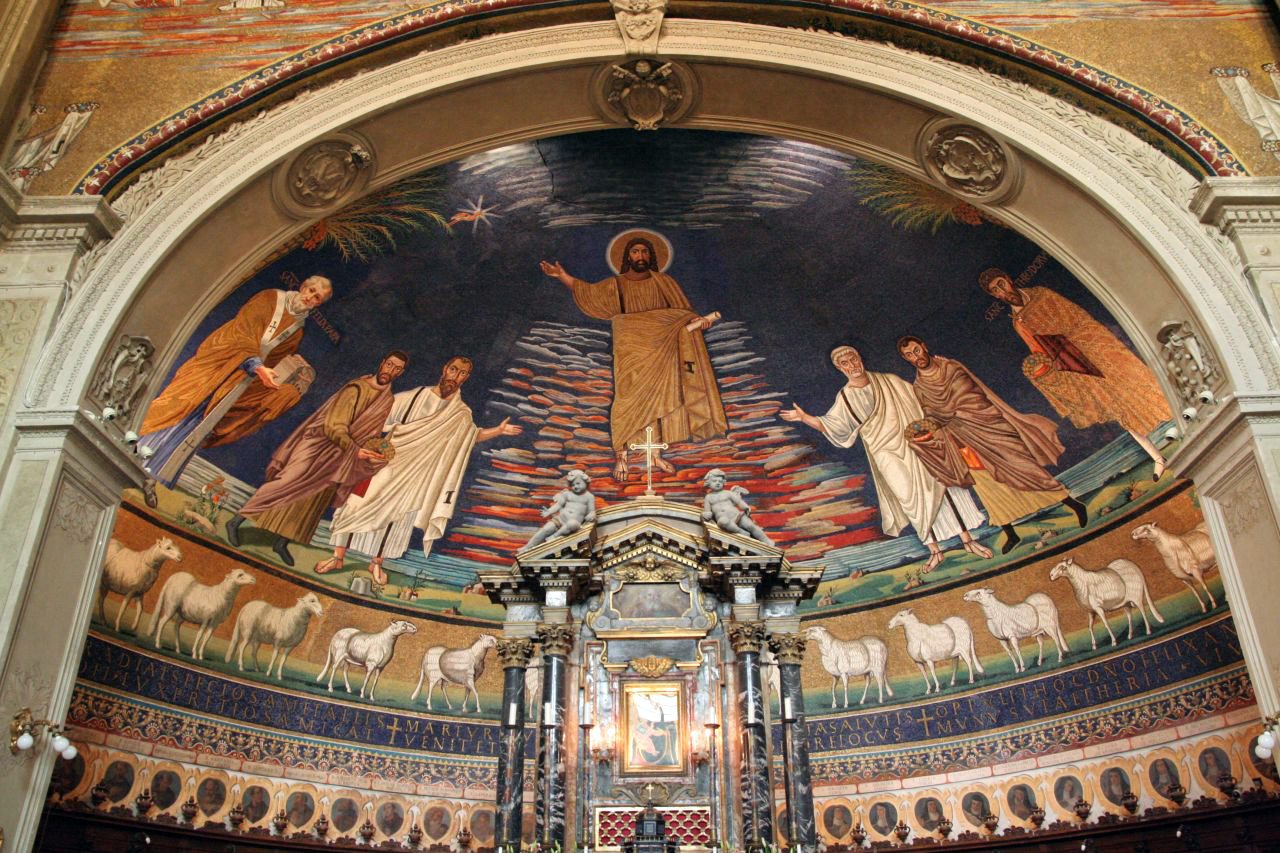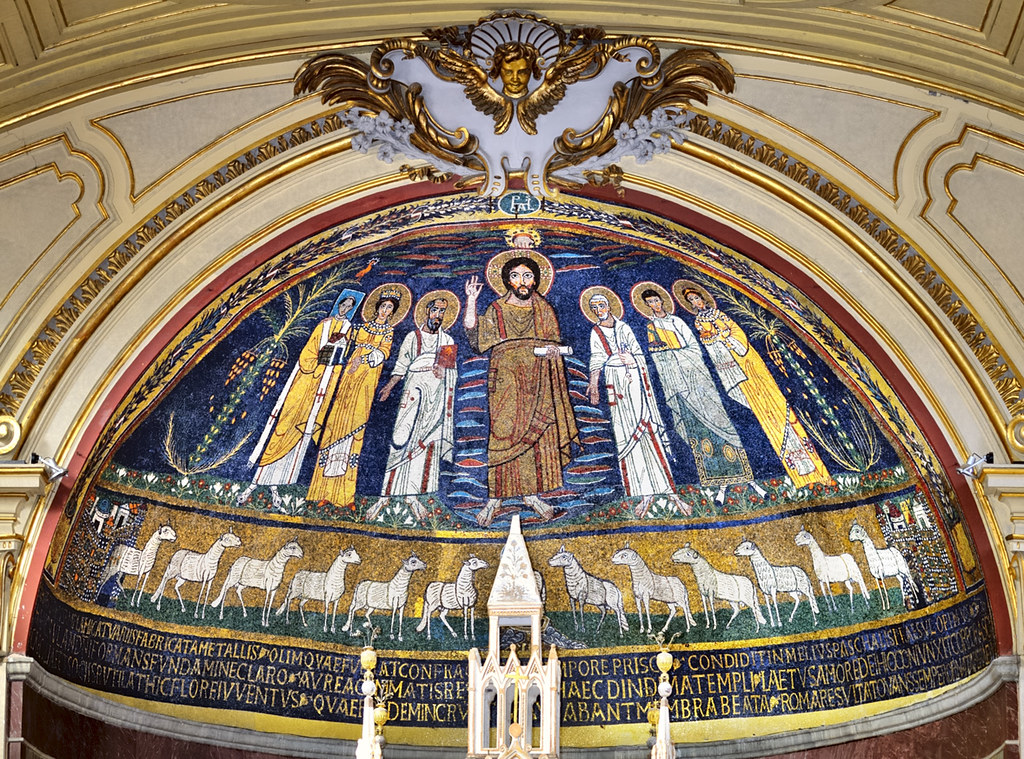First, a few definitions. The apse is the semi-circular space behind the altar in church built on a basilica plan. In contemporary usage, a basilica is a church, usually large, that is distinguished by its grandness and beauty. According to this system, basilicas need not be old, and the architectural style and floor plan are not important. I do not know by what process a church becomes a basilica, but I do know that basilicas are entitled to display an umbraculum, should the Pope decide to stop by for a visit and need to be shielded from the sun.
Anyway, the word "basilica" originally indicated a floor plan, specifically the following:
A basilica could serve any number of purposes, like a "big-box store" or a strip mall. They were originally associated with government functions, and so were called "basilicas," from the Greek "basileus," meaning king. In the Roman period, they were used mainly as law courts, and the judge would sit on a throne (cathedra) in the apse. When Constantine decided to build the first church, St. John Lateran, he built it in the form of a basilica, and put the bishop on the judge's cathedra. St. John Lateran's facade bears the inscription "mater omnium ecclesiarum," which means quite literally the "mother of all churches." Despite being the cathedral of Rome and predating the construction of St. Peter's, St. John Lateran has always played second fiddle. Nonetheless, as the first purpose-built, public church in the world, it deserves its description as "mater omnium ecclesiarum."
In the diagram, you can see the transept (#2) extending north-south against the main east-west axis of the building. This was a Christian innovation that gave the basilica a vaguely cruciform aspect that became more pronounced as the centuries progressed. The Church, that is the Body of Christ, was housed in a church shaped like a body, with its head, the bishop, in the apse (#1), and the people, riding in the nave (Latin for "ship," #3) on their pilgrimage through life.
Nearly every church in the world constructed between the early fourth century and the middle of the twentieth century followed the plan set by St. John Lateran. Quite the successful meme...
The ancient churches of Rome are rich in apse mosaics. The earliest, in Santa Pudenziana, is the earliest surviving example. Since it dates from the fourth century, it may in fact be the earliest.
In the Church of Cosmas and Damian, dating from the sixth-century, the style still recognizably continues antique forms, but there is a new Christian spirit animating the artistic program.
Peter and Paul are still senators, but Christ has gone from Roman magistrate to King of the Universe. The composition leads us up into heaven, and the twelve sheep make their first appearance, an irruption of specifically Christian symbolism. Also notice the gold inscription on the blue field below the sheep, for reasons that will become clear soon.
In the next centuries, Rome experienced a period of decline as Goths and Byzantines fought for control of Italy. Once they had exhausted each other, the Arian Lombards arrived in the peninsula as the last of the barbarian hordes. Though converted to Catholicism in the second half of the seventh century, the Lombards continued to harass the Papacy and the Byzantine officials who still claimed to represent the legitimate government of Italy. Near the end of the eighth century, the Pope, tired of waiting for Eastern aid that never came, invited the Franks to take Italy. When Leo III crowned Charles, son of Pepin, on Christmas Day, 800, he set in motion the chain of events that would create the Holy Roman Empire and the Papal States, and lend the newly crowned emperor the nickname "Charlemagne."
The watchword for Charlemagne's cultural project was "Renovatio," which, in a reversal of modern expectations, meant making new things look old. Scholars call the ninth century the "Carolingian Renaissance." Given the excellence of art, music, literature, liturgy, and culture in the period, I cannot understand why it has become fashionable to problematize this term. But that historiographical problem need not delay us now. As in any renaissance, the Carolingian period was looking for authenticity and turned ad fontes. Here is an image of the apse of Santa Prassede, made in the early ninth century:
And of Santa Cecilia in Trastevere, roughly contemporary:
At Santa Maria in Domnica, a new subject inspires a more interesting composition:
I love the communion of saints surrounding the Virgin with their countless haloes. The extension of the mosaic out of the apse into the church draws you in and makes you feel like you are part of the image.
Rome fell into decline in the tenth century and in 1084, suffered greatly when sacked by the Normans. Once again, the Popes looked to the past to inform their work in the present, producing what is probably the most highly regarded apse mosaic in Rome.
Witness the glory of San Clemente:
Santa Maria in Trastevere, executed somewhat later, retains many of the formal features of its predecessors but is becoming more and more medieval:
One final mosaic, from Santa Maria Maggiore, finished near the end of the thirteenth century, completes the series:
The sheep and the inscription have disappeared, and a new emphasis on depth and perspective can be seen in the disposition of Christ and the Virgin. The Saints turn toward them, no longer confronting the viewer. We have a scene rather than an icon. At the same time that this mosaic was being executed, Cimabue was painting the frescoes that would be the impetus for the new movement in art that we call the Renaissance. Bringing to an end the millennial reign of the apse mosaic, the fresco would became the center of church decoration and would continue in that role for the next 500 years.








No comments:
Post a Comment